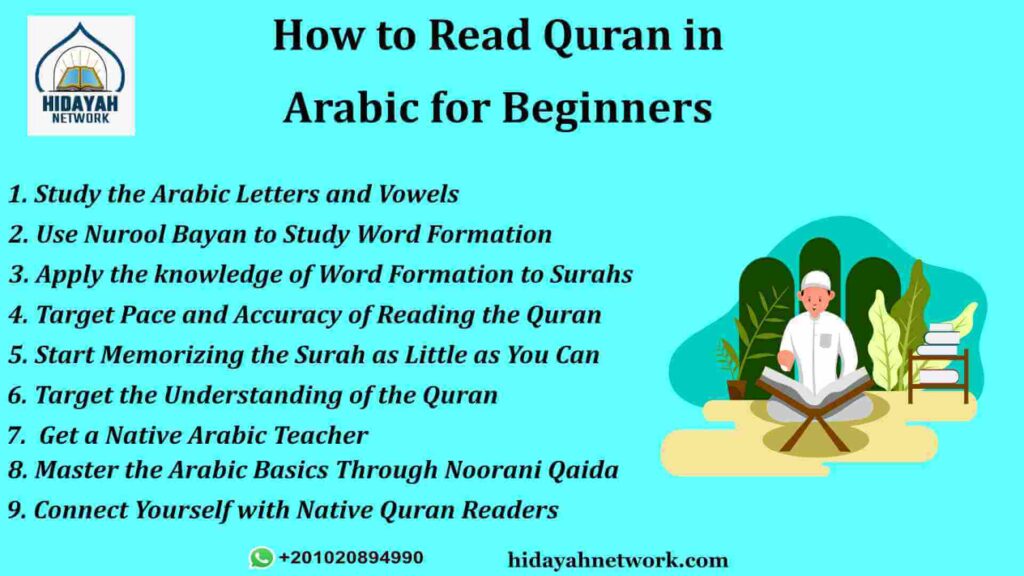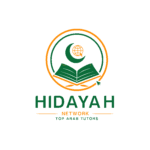The Quran was revealed in Arabic by Allah. All other translated Qurans are efforts of scholars who want people to understand the Quran. For beginners who want to learn how to read Quran in its original form, which is Arabic, they need to learn the Arabic language. And for that, thankfully, there are multiple ways to read Quran in Arabic for beginners.
You can study the Arabic letters and vowels at first, use Noorul Bayan to study word formulation, master the Arabic basics through Noorani Qaida, connect yourself with native Arabic speakers, and so on. With similar insights coming your way, we encourage you to stay with us right until the end to ensure you learn to read the Quran in Arabic as effectively as possible as a beginner. Let’s get going!
Table of Contents
Toggle9 Tips to Read the Quran in Arabic for Beginners

1. Study the Arabic Letters and Vowels
As you begin the journey of learning how to read the Quran in Arabic, the first thing to do is to study the Arabic letters and vowels. The Arabic letters consist of 28 letters which begin with Alif and end with Yau. After the letters, the vowels come next.
The vowels are eight which are:
- Fathah
- Kasra
- Dumma
- Sukoon
- Shadda
- Fathataan
- Kasrataan
- Dummataan.
When these vowels come in contact with any letter, they produce different unique sounds. Let us use one of the alphabets to demonstrate the sounds of different vowels.
Let us take the letter ‘’Ba’’ for example.
If Alif meets the letter Ba, it produces the ‘Ba’ sound.
- When it meets Kasra, it becomes ‘’Bi’’.
- For Dumma, it produces ‘’Bu’’.
- For Fathataan, it becomes ‘’Baan’’
- For Kesrataan, it becomes ‘’Bin’’
- For Dummataan, it becomes ‘’Buun’’.
These are the first basic knowledge a beginner needs to know.
2. Use Nurool Bayan to Study Word Formation
The next important knowledge for beginners who want to learn how to recite the Quran in Arabic is the knowledge of word formation.
When letters are joined together, they form words. When words are joined together, they form sentences. The knowledge of word formation can be obtained from a book called Nurool Bayan.
Nurool Bayan is a 45-page book written by Tariq Al-Saeed. The book is written in a step-by-step approach for beginners who do not have any knowledge of Arabic letters. Also, the book will expose beginners to the knowledge of Tajweed which is an important knowledge for reciting the Quran properly.
After completing Nurool Bayan, students will be able to join Arabic letters to form words. They will also be able to read the words collectively with Arabic letters.
Get 40% OFF Now!
3. Apply the knowledge of Word Formation to Surahs
Understanding the formation of words in Arabic is crucial for comprehending the Quranic verses. Break down the words into their root forms, prefixes, and suffixes.
For instance, in Surah Al-Fatiha, the word “Alhamdulillah” can be broken into “Al-hamd” meaning praise and “Lillah” meaning for Allah. This knowledge aids in grasping the deep meanings of the verses.
Prophet Muhammad (PBUH) said: “Whoever recites a letter from the Book of Allah, he will be credited with a good deed.” (Bukhari).But when you want to start, do not start with surahs like Surah Al-Baqarah, Al-Imran, or Nisai. Start with the short ones that you can easily read in one or two minutes.
4. Target Pace and Accuracy
When aiming for an optimal pace in Quranic reading, focus on finding a balance between swiftness and comprehension. Speed should not compromise accuracy. For instance:
For Targeting Pace:
- Start with a moderate pace, gradually increasing speed.
- Ensure each word is articulated clearly before moving to the next.
- Strive for a rhythm that aligns with your understanding.
Prophet Muhammad (PBUH) emphasized: “The Quran is to be recited in a measured way.” (Bukhari)
Prioritize accuracy over speed in Quranic reading. Pronounce each letter correctly, adhering to Tajweed rules. Precision ensures a respectful and accurate recitation of Allah’s words. Consider the following:
For Targeting Accuracy:
- Focus on proper articulation of each letter.
- Pay attention to Tajweed rules for accurate pronunciation.
- Regularly review and seek guidance for improvement.
5. Start Memorizing the Surah as Little as You Can
Memorizing a surah means the surah is in your memory which is one of the ways to learn Quran. Scholars usually encourage students of knowledge to target how to memorize the Quran first before vying for other knowledge like Fiqh, Hadith, and Usool.
6. Target the Understanding of the Quran
The easiest way to learn something is to understand it first. As soon as you begin to recite the Quran and start memorizing it, you should try to learn the meaning of the verses of the Quran.
Knowing the meaning of the verses of the Quran helps in the recitation of the Quran. It will guide the reciter on where to pause and where not to in order not to change the intended meaning of a verse.
7. Get a Native Arabic Teacher
If you want your Quran journey to be fast and easy, it is better to get a teacher through beginners Quran classes. Not just any teacher, but a native Arabic teacher who understands the Quran and the Arabic language very well.
Scholars say it is the best method of learning not only the Quran but all Islamic knowledge in general.
Sheikh Muhammad Shummuni said,
‘’The one who is listening verbally to a Shaykh or scholar face to face, he is far away from getting the wrong knowledge. However, the one who is just studying from books will not be considered as a holder of knowledge.’’
Al-Imam al-Gazari also said that there is a unanimous agreement that the Quran must be taught in the same way of receiving it from Imam after Imam (Shaykh after Shaykh) up to Prophet Muhammad (peace and blessings of Allah be upon him) so that other ways of receiving it are rejected and not accepted.
The two quotes from these scholars point to the fact that taking knowledge from scholars directly is very important. To them, anybody who claims to be a scholar without having a Shaykh is not a scholar.
8. Master the Arabic Basics Through Noorani Qaida
Mastering the Arabic basics through Noorani Qaida is an effective way for beginners to lay a strong foundation for Quranic reading. Noorani Qaida is a widely used instructional book that systematically introduces learners to Arabic letters, pronunciation, and basic grammar rules.
It incorporates interactive exercises, guiding students through gradual progression. By emphasizing essential skills, such as letter recognition and proper pronunciation, Noorani Qaida ensures a solid understanding of the fundamentals.
- Utilize Noorani Qaida for Systematic Learning.
- Focus on Letter Recognition and Pronunciation.
- Engage in Interactive Exercises for Practice.
9. Connect Yourself with Native Quran Readers
Connecting yourself with native Quran readers is a valuable step in enhancing your Quranic reading journey. Immersing in the language and melody of native readers provides an authentic understanding of pronunciation, intonation, and proper recitation.
Prophet Muhammad (PBUH) emphasized the importance of acquiring the Quranic knowledge, stating, “The best among you are those who learn the Quran and teach it.” By associating with those well-versed in Quranic recitation, you not only gain linguistic insights but also foster a deeper connection with the spiritual essence of the Quran.
How to Read Quran in Arabic Correctly?
To read the Quran in Arabic correctly, consider these essential tips:
- Learn rules for accurate Quranic pronunciation.
- Consistent practice improves fluency and comprehension.
- Emulate skilled Quranic reciters for correct intonation.
- Enroll in classes for guided and structured learning.
- Get guidance from knowledgeable tutors for improvement.
- Combine recitation with mindful contemplation for understanding.
How to Read the Quran in Arabic Without Mistakes?
For flawless Quranic reading in Arabic, consider these distinctive strategies:
- Read facing a mirror to self-correct pronunciation instantly.
- Record your recitation, analyze errors, and make necessary adjustments.
- Use hand movements to connect letters, aiding in accurate pronunciation.
- Employ memory aids for remembering pronunciation rules and patterns.
- Create visual charts linking letters to sounds for effective recall.
- Engage in communal recitation to receive real-time feedback and corrections.
- Assign colors to different letter categories for visual recognition and correction.
Conclusion
Finally, if you are a beginner who wants to learn how to read the Quran in Arabic then learn quranic arabic programs, these are the tips you need. These tips were carefully selected by us because we believe they are the best for beginners.
Frequently Asked Questions
Although some people believe beginners do not need to recite the Quran in chronological order, we believe reciting the Quran in chronological order is the best for beginners. It is the best way for beginners to measure how much progress they have made in their Quran journey.
Tajweed is a familiar term for those who have learned to recite the Quran. The literal meaning of the word is ‘to perfect, to beautify, or to improve.’
After Allah, the second highest word that appears in the Quran is Ilm (knowledge).
Whenever Noon or Meem has a Tashdeed, make Ghunnah (a long nasal sound).
The two most common tajweed mistakes made by non-Arabs are the timings of the vowels and Madd letters, and the articulation points of the letters.

About Author
Related Blogs
Dive Deeper into Related Topics

